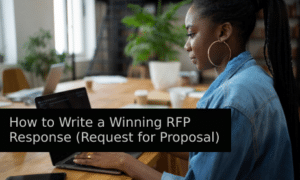Feeling like your SaaS proposals are getting lost in the black hole of unanswered emails? Especially when you send it to high-value clients. Cracking those deals is tough.
You’ve got the best product and top-quality service offerings, but are your SaaS clients seeing the potential value in them? If not, it’s time to look at the proposal.
A well-crafted proposal can set the right tone from the start. But it must go beyond features and pricing to resonate with those top-tier clients. Well, that’s an art in itself.
In this article, we’ll uncover key tips for crafting proposals that turn skeptical prospects into raving fans – and, more importantly, into signed contracts.
By the end of it, you’ll have much clarity on how to navigate proposal-writing challenges. Expect to understand SaaS customer pain points and demonstrate how your services help them unlock their success.
Let’s first cover the basics.
What are Proposals for SaaS Clients?
Business proposals are sales pitches in document form. They outline the value proposition of your product or service offerings to potential customers.
It typically includes information about the client’s needs, how your services can address those, a pricing structure, and a call to action.
But, there can be no cookie-cutter approach in proposals, especially if you are targeting high-end SaaS clients. 81% of customers prefer companies offering personalized experiences.
So why not personalize a proposal as well to set the right tone!
The proposal should demonstrate your expertise, tailor your solution, and build trust before the contract’s ink dries.
Ready to start crafting winning proposals?
Let’s go!

Deep-Dive into Your Client’s World
Before you start drafting your proposal, become an expert on your potential client. Targeting high-value SaaS clients means knowing how they conduct their business, audiences, and brand image.
Consider the following approach to understand what constitutes your top-end client’s world.
Add Data-Driven Insights
Use data to drive effective SaaS proposals by highlighting and quantifying the impact of your services on the SaaS prospect. For instance, as a SaaS marketer, you can track engagement metrics, identify potential bottlenecks, and leverage real-time data and analytics to monitor their current performances.
Shift your proposal’s focus to how your offerings can provide value for money. Do you think your service or product boosts clients’ revenue? If so, bringing in the annual recurring revenue sounds persuasive.
Tell (and show) if you have boosted the ARR (annual recurring revenue) of similar clients through case studies or predictive analytics. This demonstrates the financial benefit of your offering and aligns well with most SaaS companies’ objectives to sustainably enhance their revenue streams.
For this, you’d need to —
- Use Existing Tools: If they’re already using any software, look into the tool and how it’s (or isn’t) addressing their needs. This reveals integration possibilities or where your solution can surpass what they currently have.
- Check Web Analytics: Try to gain access to prospects’ website analytics (if public). High bounce rates, low time-on-page, or traffic sources reveal areas where user experience needs improvement and could be addressed by your SaaS product.

Conduct a Thorough Research
Get into the nitty-gritty of what forms your prospective SaaS client’s world. Aim to use this information for tailoring your proposals to their specific needs and requirements.
For instance, understanding their industry, business goals, and challenges lets you showcase how your services or products can effectively address them.
Also, a well-researched proposal shows you’ve invested in understanding their business, solutions, and audiences.
Here’s how to get started.
- Company Resources: Research the company’s website, recent press releases, annual reports, and social media feeds. Look for mentions of its mission, current initiatives, and any pain points it faces.
- Industry Trends: Research industry publications, analyst reports, and competitor analysis. It provides insights into the broader context of their challenges and opportunities.
The Power of Direct Conversation
Sending proposals to SaaS prospects will require leveraging direct conversation to connect with prospects personally. This offers an opportunity to understand their unique challenges and needs and tailor your proposal accordingly.
Initiate the conversation to demonstrate your genuine interest in their business and showcase that you’re not just sending a generic proposal. This connection humanizes the interaction and makes the prospect more receptive to your proposal.
For this, you can consider —
- Discovery Calls: Prepare open-ended questions that get them talking about their workflows, where things aren’t running smoothly and their overarching business goals.
- Focus on the Decision-Makers: Target your conversations towards the people who will have the final say in choosing a SaaS solution. Understanding their perspective is vital.

Build Trust with Social Proof
High-value SaaS clients are savvy. They want more than bold claims; they want evidence that your solution delivers results.
Showcase —
- Success stories of existing clients
- Their testimonials
- Logos of reputable companies that use your service
- Client’s achievements while using your services
Such social proof should emphasize your product’s popularity through numbers which can be a great conversation-starter.
For this, you can consider the following actions.
Put Current Clients’ Success Stories in the Spotlight
Create case studies to provide the most depth. In this, outline a client’s challenge, your service or product implementation, and the quantifiable outcomes (e.g., 18% increase in lead conversion, 7% cost reduction).
Display Client Testimonials
Proposals with testimonials can go a long way in building trust. For this, choose testimonials highlighting specific pain points the prospect is likely to share. Again, filter out testimonials for different clients based on their industry, pain points, business goals, target customers, etc.
Industry Accolades and Recognition
Have you won awards or been featured in respected publications? If so, mention those in the proposal to add an objective layer of credibility to your proposal.
How to Choose the Right Social Proof
Some quick tips will help you get started sorting out the social proof dilemma. Are you confused about when to use which—testimonial, case study, or even how to choose the right one?
Here are key tips for clarity.
- Relevance: Match case studies and testimonials to the prospect’s industry and specific business concerns as closely as possible.
- Concise yet meaningful: Include enough detail to make the social proof compelling. Avoid lengthy write-ups that break up the flow of your proposal. And, if providing case studies, provide links to full case studies for those who want to explore further.
- Reflecting current prospects: Clients see themselves reflected in your success stories. Reading about others should make them want to be a part of them. The goal is to let the prospects feel you can achieve incredible results.
Make Pricing Crystal Clear (and Strategic)
Nothing derails a promising deal faster than a confusing or poorly structured pricing section.
Clarity should take center stage. Pair it with a strategy that aligns your pricing with the client’s perceived value.
Consider the client’s needs, conduct market research, offer clear pricing options, and highlight your value proposition.
Here are some ways to get started.
Keep it Simple and Transparent
Include a simple and transparent cost structure that clarifies your proposal and builds trust with potential clients.
A well-articulated cost structure simplifies the understanding of pricing and billing, simplifying informed decisions for SaaS prospects.
Here’s what you can do:
- Easy-to-find breakdown: Don’t make prospects hunt for pricing information. Include a clear, dedicated section right in the proposal.
- No surprise fees: List all costs explicitly, including potential setup fees, onboarding, or optional add-ons.
Strategic Pricing Considerations
Offer multiple packages to suit different budgets and needs. This shows flexibility and helps prospects self-select into the appropriate tier.
For this, consider —
Competitor Analysis: Understand where your pricing sits within the market landscape. Are you a premium offering or a more budget-friendly option? Make sure your messaging reflects this positioning.
Free Trials/Demos: If you feel that the prospect isn’t sure of your offerings, do not hesitate to provide trials and demos. Mention the trial period or demo assignment to build confidence, allowing them to experience the value firsthand before making a financial commitment.
Pro Tip: Include a FAQ section in your proposal to address common questions about pricing, payment terms, or upgrades.
Nail the Call to Action (CTA) to Seal the Deal
Your proposal has done the heavy lifting to demonstrate value, build trust, and (ideally) leave the prospect wanting more.
But don’t leave them hanging on what’s next! Slide in a compelling CTA that informs prospects of the next steps they need to take.
Here’s how to get started with CTA.
Insert One Clear CTA
Avoid overwhelming the prospect with too many options. Focus on a single, primary action you want them to take. Ensure this CTA stands out in terms of graphics, colors, and text so readers don’t miss it.
Make it Specific
Be specific with your CTA, which mentions what you need the prospect to do. So, instead of generic ‘contact us’ consider CTA texts like —
- “Schedule a personalized demo.”
- “Let’s discuss your pricing needs.”
- “Ready to get started? Sign the contract today.”
Urgency (But Not Pressure)
Inject a sense of timely action by using phrases like “limited-time offer,” “schedule your demo while spots are available,” or “start seeing results faster.” Tap into the prospect’s FOMO (Fear Of Missing Out), which compels them to act ‘now.’
Master the Follow-Up
Once you’ve sent off a well-crafted proposal, the work doesn’t stop there. Following up is crucial, especially when dealing with high-value SaaS clients who often juggle multiple priorities.
A strategic follow-up can keep your proposal top-of-mind, clarify any uncertainties, and demonstrate your commitment to their success.
Aim to initiate follow-up within a week of sending your proposal, to communicate eagerness without seeming pushy. Utilize this opportunity to answer questions, offer additional insights, or even include a minor update or relevant piece of content that adds value to the discussion.
Conclusion
Crafting proposals that seal the deal isn’t magic—you’ll need to understand your prospects, communicate value, and be strategic. It’s time you transform your proposals into powerful sales tools by ditching generic pitches and embracing the tips we just explored above.
Think of it this way: every time you put in the extra effort to research your client’s needs and show them the value of their investment, you’re —
- Building deeper trust with potential partners
- Demonstrating your expertise and commitment to their success
- Increasing your chances of landing those coveted high-value SaaS contracts
And yes, don’t forget to foolproof your proposals with proofreading and editing. This ensures that the language does not become a barrier in closing the lead.
About Author
Hazel Raoult is a marketing manager at PRmention. She has over eight years of experience writing about ecommerce, entrepreneurship, and B2B SaaS. Her work has been published in leading publications such as The Future of Commerce, ChatBot, Martech Zone, OROCommerce and to name a few. You can get in touch with her on Linkedin.




